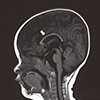Dear Editor,
1p36 deletion syndrome is the most common terminal chromosomal deletion in humans, affecting 1 in 5,000 newborns [123]. Common clinical features include developmental delay, hypotonia, seizures, learning difficulties, feeding difficulties, cardiomyopathy, hearing loss, and visual defects. In most cases, the terminal end or the distal critical region of the chromosome is missing, and most breakpoints occur within the distal 10.5 Mb of 1p36 [2]. In 2007, five cases of children with interstitial deletions in a more proximal region, 1p36.23-1p36.11, were reported [3]. Unlike most cases of 1p36 deletion, these children exhibited frontal and parietal bossing, epicanthal folds, and hirsutism. We recently identified a patient with a 1p36.11-p35.3 interstitial deletion in a region more proximal than previously reported. Here, we described the phenotype of this patient and reviewed the possible genotype related to the clinical features. To our knowledge, this is the first case of de novo 1p36.11-p35.3 interstitial deletion, encompassing AHDC1.
A 12-month-old boy presented at Incheon St. Mary's Hospital, Korea, with global developmental delay. He was born after 39 weeks and 6 days of gestation by spontaneous vaginal delivery, with a birth weight of 3.48 kg (25–50th percentile). The patient was a firstborn child; the pregnancy was uncomplicated, and the family history was noncontributory. At presentation, the patient's height was 73 cm (5–10th percentile), body weight was 10.6 kg (50–75th percentile), and head circumference was 48 cm (90–95th percentile). The patient exhibited hypotonia; he could roll over and sit without arm support but could not creep or crawl. He possessed a simian crease, but a Down syndrome evaluation showed no abnormalities. Bayley Scales-based developmental evaluation indicated an approximately 5-month delay in receptive language cognitive ability and fine and gross motor domain scores and approximately 10-month delay in expressive language score. Brain magnetic resonance imaging (MRI) showed corpus callosum thinning (Fig. 1). Nerve conduction and electromyography evaluations were normal. A Denver Development Screening Test II administered at 28 months of age revealed personal-social, fine-motor adaptive, gross-motor, and language skill equivalents of 20, 17, 12, and 7 months, respectively.
The patient was referred to the genetic clinic for further evaluation. Written informed consent was obtained from the patient's parents after they have been briefed about the study. This study was approved by the institutional review board of the Catholic University of Korea, Incheon St. Mary's Hospital. Chromosome analysis revealed 46,XY at the 550 band level, and an array comparative genomic hybridization (CGH) revealed a de novo 1p36.11-p35.3 interstitial deletion. The deletion size was estimated to be 1 Mb, and the deleted base pairs of chromosome 1 spanned 27,750,155–28,754,771 (hg18) (Fig. 2). The array CGH of both parents revealed no abnormalities, confirming the de novo origin of the deletion. Approximately 20 known genes were included in this region, among which 13 genes were registered in the Online Mendelian Inheritance in Man (OMIM) database. However, according to a search of the Developmental Disorders Genotype-Phenotype Database (DDG2P), only AHDC1 has been confirmed as a morbid gene responsible for a developmental disorder. The other 12 genes (ATPIF1, EYA3, FGR, IFI6, MED18, PHACTR4, PPP1R8, PTAFR, RPA2, SESN2, STX12, and WASF2) were found to have no relationship with the specific developmental phenotype of the patient. Therefore, we could exclude the involvement of other genes in the abnormal phenotype of the patient. AHDC1 (OMIM 615790) is a protein-coding gene located on the short arm of chromosome 1 (1p36.1-p35.3). In 2014, Xia et al [4] reported four unrelated children with mental retardation exhibiting clinical features consistent with developmental delay, congenital hypotonia, mildly dysmorphic features, and sleep apnea. All four exhibited a developmental delay in expressive language and hypoplasia of the corpus callosum on brain MRI. Mutations in AHDC1 were confirmed by whole-exome sequencing [4].
This patient possessed an interstitial deletion in 1p36.11-p35.3, where AHDC1 is located, and showed congenital hypotonia and delay in development of gross motor skills and expressive language. Brain MRI showed corpus callosum thinning. Although the patient's clinical features were typical of those seen in 1p36 deletion and proximal 1p36 interstitial deletion, his phenotype more closely resembled that of cases with de novo truncated mutations in AHDC1. Many cases of 1p36 deletion have been reported, but to our knowledge, this is the first report of a de novo 1p36.11-p35.3 interstitial deletion with loss of AHDC1. Molecular studies are needed to identify the genotype-phenotype relationship of this deletion and to understand the effects of AHDC1 expression.
Figures and Tables
Acknowledgments
This study was supported by the Research Fund of Seoul St. Mary's Hospital, The Catholic University of Korea.
References
1. Jordan VK, Zaveri HP, Scott DA. 1p36 deletion syndrome: an update. Appl Clin Genet. 2015; 8:189–200.
2. Heilstedt HA, Ballif BC, Howard LA, Lewis RA, Stal S, Kashork CD, et al. Physical map of 1p36, placement of breakpoints in monosomy 1p36, and clinical characterization of the syndrome. Am J Hum Genet. 2003; 72:1200–1212.





 PDF
PDF ePub
ePub Citation
Citation Print
Print




 XML Download
XML Download